Glue sticks help solve 3D printing bed adhesion issues. If your print isn’t correctly sticking to the build plate, you can apply glue or another 3D printer adhesive to prevent warping or curling.
Glue stick can also help if your print is sticking too tightly to the build plate, since a good glue lets your print pop right off as soon as the plate cools. For those reasons, glue sticks are an important part of any 3D printing toolkit.
The kind of glue used for 3D printing varies, but generally weak, water-soluble glues are best for bed adhesion.
The best glues adhere your print perfectly to the print bed, are easy to clean up, and let your print detach again without force.
We’ve tested and recommended our top 4 glue sticks below, as well as some tips and tricks on where and when to use each glue for each type of project, filament, and more.
Quick Overview
- Layerneer Bed Weld: Best overall
- Elmer’s Disappearing Purple Glue Stick: Best budget pick
- Magigoo MO2016: Compatible with the most filaments
- 3D Gloop!: Good multi-purpose glue
1. Best Glue Overall: Layerneer Bed Weld
- Price: Check latest price at Amazon here
- Size: 6.38 oz
- Format: Liquid
- Applicator: Foam tip
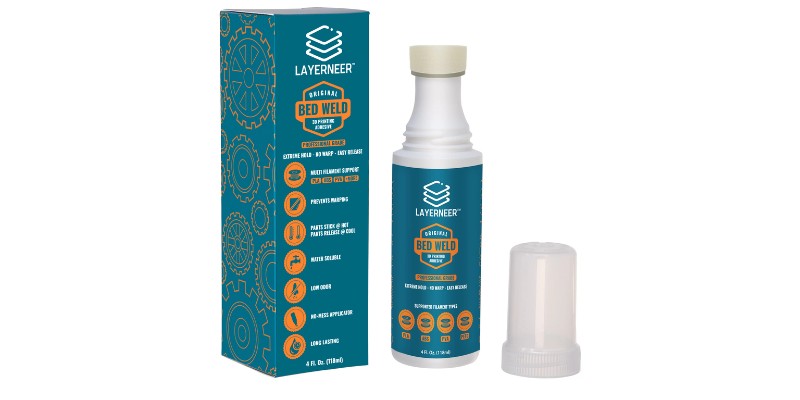
If you want consistently perfect adhesion in a variety of 3D printing situations, then Layerneer Bed Weld is hands down the best on the market. Though, I understand that the $23 you’ll need to spend might be intimidating, especially after I’ve just covered the super budget option.
But even though nothing can beat Elmer’s glue stick in terms of value, Layerneer certainly tries. You get a full 6.38 oz (unlike other specialty brands like Magigoo), and it’s fully re-wettable, so each and every application works for multiple prints.
You only need the one glue stick for a variety of filaments, including PLA, ABS, PETG, PC, ASA, PET, and more.
However, certain filaments like TPU aren’t supported. Layerneer reports a small amount of corner lifting with TPU on their internal warp stress tests, but some people have found a great deal of success with it regardless.
Overall, Layerneer Bed Weld has superb adhesion and makes things easy to pop off the print bed as soon as it cools. In other words, it works for both types of adhesion issues: over adhesion and under-adhesion. I rate it as the best on the market for all these reasons.
Layerneer is even better for beginners than popular options like Magigoo because the applicator is less finicky, and it’s super easy to remove. A wash in warm water with dish soap should do the job – no scraping required.
2. Best Budget Glue: Elmer’s Disappearing Purple Glue Stick
- Price: Check latest price at Amazon here
- Size: 0.21 oz per stick, 2.52 oz for a 12 pack
- Format: Gel
- Applicator: Glue stick
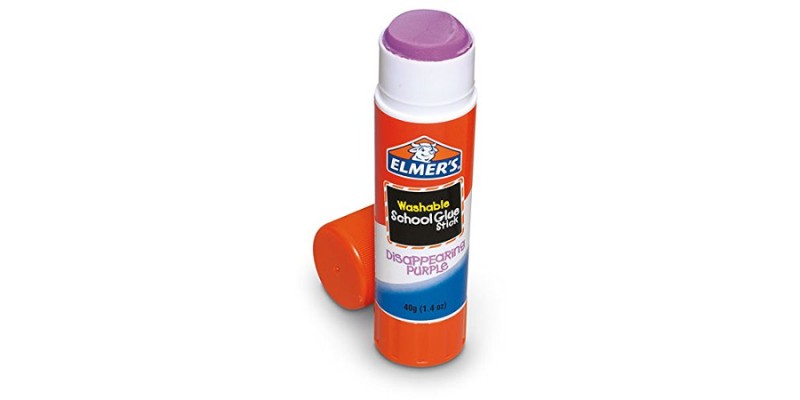
The infamous Elmer’s glue stick is a mainstay in forum recommendations for a reason: it’s cheap, it gets the job done… and have I mentioned that it’s cheap?
Specifically, I suggest buying the Disappearing Purple glue stick if you don’t want to invest $20 on a specialty adhesive. It’s purple, so you can tell where you’ve spread it (and, importantly for bed adhesion, how evenly you’ve spread it), then dries clear.
Elmer’s glue is easy to apply – even a 5-year-old can do it – and is a very functional adhesive for using with typical 3D printer filaments like PLA, PETG, and ABS.
You might already have some in your home, which is why we recommend trying an Elmer’s glue stick to see if it fixes your problems first, before searching far and wide for anything else.
So, why would you ever want to use a specialty glue when 12 sticks of Elmer’s is only $6?
Tragically, Elmer’s doesn’t work for every situation. There’s a complicated range of different factors that go into whether or not you’re getting good first layer adhesion, including the type of filament, your print bed material, the print in question, and your settings.
You can’t use the glue stick while your print bed is hot, so you better be prepared to apply it in advance. And even though it’s easy to wash off both the finished print and the bed with water or alcohol, sometimes the adhesion can be a little too intense.
Don’t be surprised if Elmer’s isn’t a miracle solution for you when you’re using non-PLA filaments, printing something with delicate parts, etc. In these situations, I recommend opting for a more specialized 3D printer glue, such as the one below.
3. Best Filament Compatibility: Magigoo MO2016
- Price: Check latest price at Amazon here
- Size: 1.69 oz
- Format: Liquid
- Applicator: Sponge tip on a stick
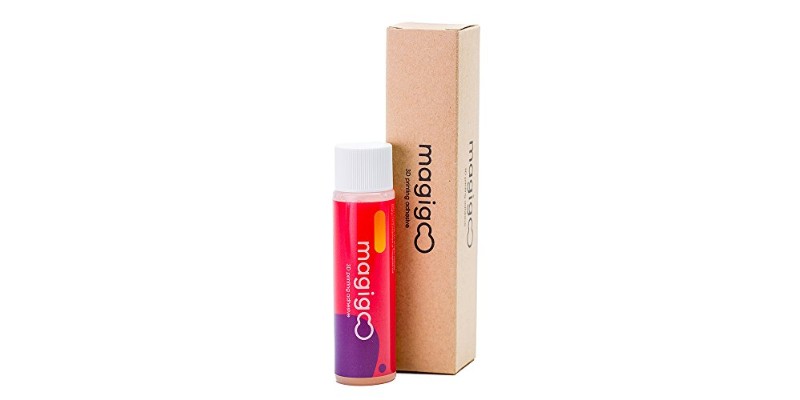
Magigoo MO2016 is a highly recommended specialty glue within the 3D printing community because it just works. It’s been well-tested by thousands of people, so you can rest assured that you’re not making a leap of faith when shelling out $20.
It works with PLA, ABS, PETG, HIPS, and more. Magigoo says you can use it for TPU as well, but they also have another glue stick made specifically for flexible filaments called Magigoo Pro Flex.
Like Elmer’s glue, Magigoo cannot be used on a hot build plate. You’ll eventually damage the dispenser and make it difficult to get more glue to come out.
Speaking of the dispenser, Magigoo has a rather unique (weird) system. It looks like a glue stick, but instead of glue that you push to the top, there’s a sponge that you squeeze liquid glue into.
This has the potential to be really intuitive and simple when compared to standard separate brush-like applicators. Unfortunately, Magigoo actually has the most finicky application of all the glues on my list.
You have to shake very thoroughly beforehand (all good so far), and then carefully get a small amount of glue into the sponge. But, if you squeeze even slightly too hard, the applicator will come right off the bottle, and your expensive $20 glue will make a mess – instead of helping you avoid one.
Magigoo is technically re-wettable, just like Layerneer Bed Weld, it just isn’t advertised as such. If you fill a spray bottle with water, give it a couple of spritzes, and swirl it around a bit, you can use one application for multiple prints.
So, considering the reliability and filament compatibility you’re getting, Magigoo is a solid secondary option to Layerneer Bed Weld – especially if TPU is giving you the most trouble. There’s little to be disappointed in (the applicator, mainly), and lots to love.
4. Best Multi-Purpose Glue: 3D Gloop!
- Price: Check latest price at 3DGloop here
- Size: 2.5 oz, Different sizes available
- Format: Liquid
- Applicator: Brush
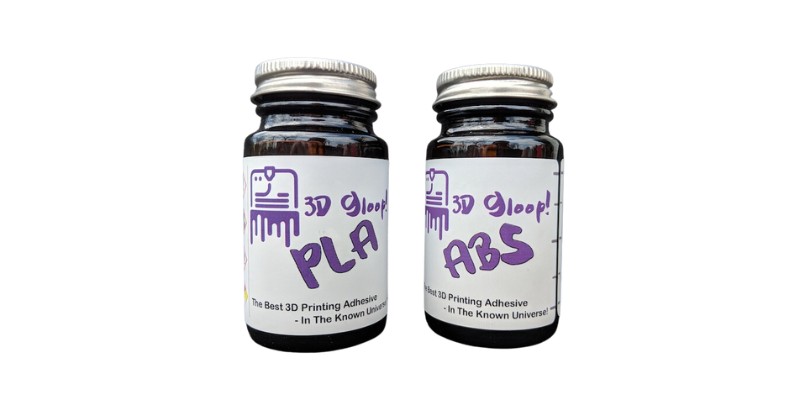
3D Gloop! is a small business with a mission to create the ultimate glue stick for 3D printing. That means their products are multi-purpose wonders, with three main use cases.
The first is fusing prints together, which is what Gloop! is mainly advertised for. But it can also be used to fix both over-adhesion and under-adhesion issues, as well as smoothing out prints in post-processing.
It’s expensive, mainly because you’re getting a 2.5 oz tub of chemical adhesive. Compared to all the other glues on this list which only excel at bed adhesion, you get a lot more bang for your buck out of Gloop!
If you ever create multi-part 3D prints, Gloop! can fuse them seamlessly. If you regularly feel annoyed with layer lines but don’t want to shell out hundreds for a resin printer, Gloop! can help with that, too. For more on this, we also have an article on the best glues for 3D prints.
Of course, it’s a perfectly functional solution for adhesion problems, even though that isn’t its main purpose. On their website, 3D Gloop! gives detailed instructions on how to use Gloop! as a bed adhesive.
Don’t get me wrong, I think Gloop! is worth it in many situations. Like every other product, though, it has some drawbacks that could make it a complete waste of money in your situation.
Firstly, Gloop! sells chemical adhesive that works for one type of filament, and their lineup includes only three different types: PLA, PET, and ABS. That might be okay depending on what you like to print with, or it might be a complete dealbreaker.
Another problem is there may be some potential design issues with the bottle. It’s commonly reported that the brush which comes with the Gloop! is too long for the container and will arrive bent. Again, not the end of the world, but it’s disappointing when you consider the price.
How To Pick The Right Glue For Your Next 3D Printing Project
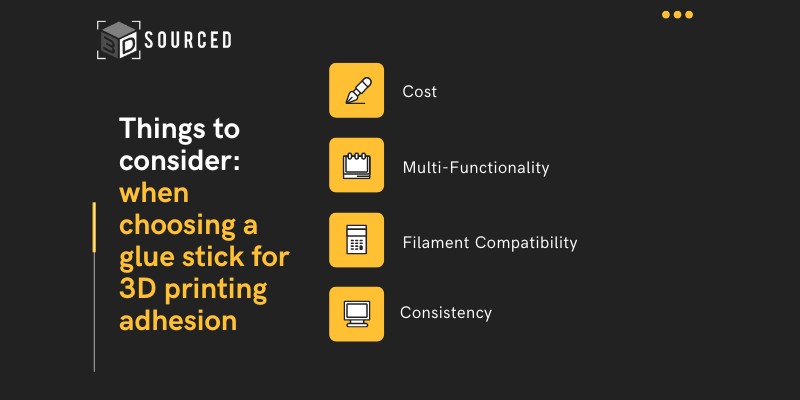
There are 4 main factors you should consider when purchasing a glue stick for 3D printing. Depending on which you prioritize, one of these recommendations will likely be the best option for you:
Cost
If you only get problems every once in a while and would rather spend your limited hobby budget on new filaments or cooler upgrades, it’s understandable to prioritize saving money.
Many specialty glues can be pricier than the value they provide to you. The best option, in this case, would be to stick with Elmer’s Disappearing Purple Glue Stick as a cheap pick, but if money is no issue, then opt for Layerneer Bed Weld.
Multi-Functionality
Although pricier, a multi-function glue offers more than just bed adhesion, and can save money buying a separate glue for attaching 3D printed parts together.
If you love the idea of being able to smooth your prints, stick them together, and have better bed adhesion, then 3D Gloop! is one of the few glues on the market that can do this.
Filament Compatibility
Many specialty glues struggle with filament coverage, for example Gloop! glues only handle a single filament. Other glues work with some basic filaments like PLA, ABS, and PETG, but struggle with anything beyond that, and Layerneer Bed Weld can run into issues with TPU.
If you know you’ll be using fancier filaments like TPU, I suggest a Magigoo glue stick.
Consistency
If you want consistent, worry-free results, then Layerneer Bed Weld is for you. It’s a very utilitarian and no-frills option.
Most filaments, most bed types, and most temperatures are totally okay with Layerneer. Your print will stick perfectly when the bed is hot, and cleanly pop off when it cools down.
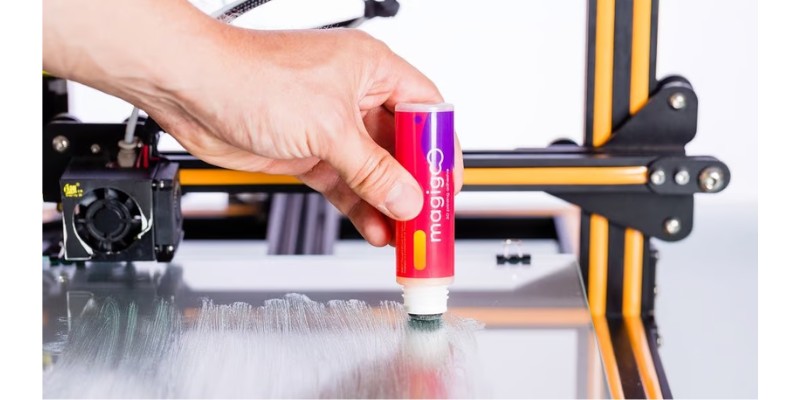
When are glue sticks best used in 3D printing?
Blue painter’s tape, Elmer’s glue, and hairspray make up the holy trinity of budget bed adhesion fixes. Out of these three, glue is what you’ll likely hear about the most. So when should you be using glue sticks over all the other options?
In my opinion, pretty much all the time.
Hairspray vs glue stick

Hairspray might help your prints stick… but it has a smell, isn’t the safest to spray all over your stepper motors and gears, and is a pain to clean up.
Glue has all the benefits, without the safety concerns and clean-up mess.
Painter’s tape vs glue stick

Painter’s tape is even worse. It only works consistently on lower bed temperatures and is slightly harder to source than the other two. It’s the type of adhesive you should use in a pinch – not your go-to solution.
Typical Elmer’s glue sticks won’t damage your build plate and will work (with varying degrees of success) with all kinds of filaments.
And, if you opt for a specialty 3D printing glue adhesive, you’ll get more consistent results and have a cleaner experience with less glue to wash off the print afterward.
When, and how, to use glue stick
Many specialty glues do have restrictions as to what types of build plates and filaments can be used with them, which limits when they’re useful.
I recommend you try Elmer’s glue first, and if this doesn’t work, just grab a specialty glue like Layerneer or Magigoo instead of messing around with the other ‘home remedies’.
FAQs:
Can you use glue stick on PLA?
Yes, you can use a glue stick as an adhesive on PLA without damaging the final print, and applying glue to the bed will help PLA stick to the plate. However, you can’t use glue stick to bind together multiple PLA pieces, as it is not a strong enough solution.
How should you use glue stick for the best adhesion?
To get the best adhesion from your glue stick, simply apply a thin and consistent layer of the glue onto your 3D printer’s build plate while it’s still cool. Make sure it covers the entire area that your print will cover. Then, print as normal.
Does glue stick help prints stick to the print bed?
Yes, a glue stick will help prints stick to the print bed by improving adhesion. Either regular Elmer’s glue or a specialty 3D printing glue will assist with adhesion and prevent warping, and will not damage the final print.





